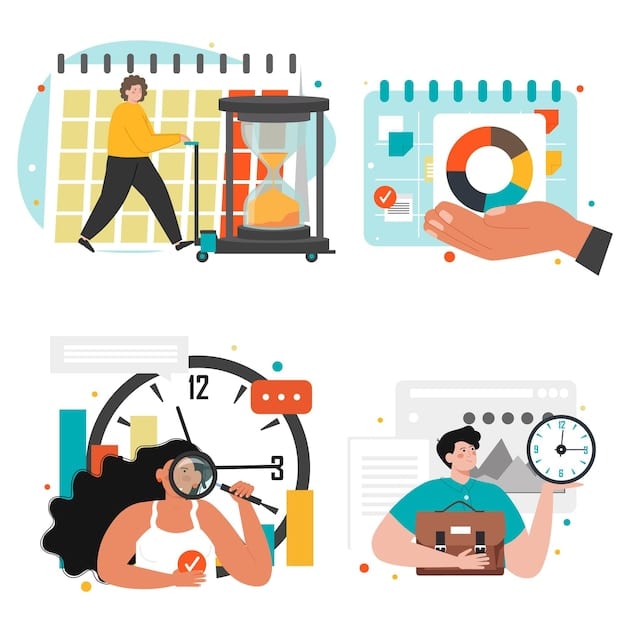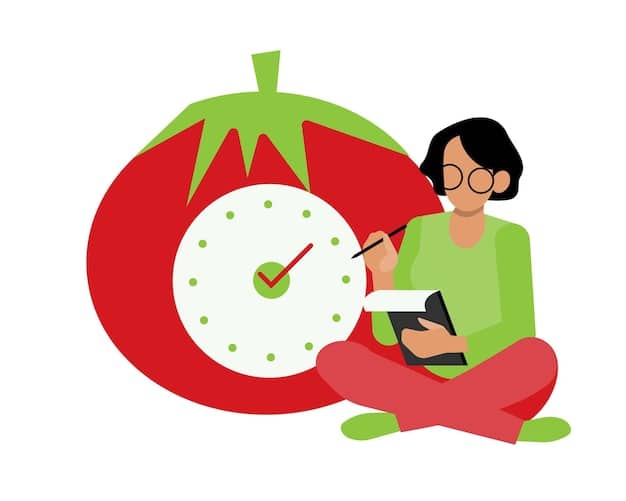Stop Procrastinating: 5 Strategies for Peak Productivity

Stop procrastinating by implementing strategies such as setting clear goals, breaking tasks into smaller steps, using time management techniques, eliminating distractions, and rewarding yourself to boost productivity and achieve your goals faster.
Do you often find yourself putting things off until the last minute? It’s a common struggle, but learning how to stop procrastinating: 5 strategies to boost your productivity and achieve your goals faster is crucial for personal and professional success.
Understanding Procrastination: Why We Do It
Procrastination isn’t simply laziness; it’s often linked to deeper emotional and psychological factors. Understanding these can help you address the root causes of your delays and take more effective action.
The Psychology Behind Delay
Procrastination often stems from fear of failure, perfectionism, or a lack of motivation. Recognizing these psychological triggers can provide insight into why you postpone tasks.
Common Triggers for Procrastination
Certain situations or types of tasks may be more likely to trigger procrastination. Identifying these patterns helps in preparing strategies to overcome them.
- Fear of Failure: Overcome by reframing failure as a learning opportunity rather than a personal defeat.
- Perfectionism: Focus on progress over perfection, accepting “good enough” to keep momentum.
- Lack of Motivation: Connect tasks to personal values and goals to increase intrinsic motivation.
By understanding the psychological roots and triggers behind procrastination, you can begin to develop and implement strategies to tackle it head-on, leading to greater productivity and achievement.

Strategy 1: Setting Clear and Achievable Goals
Establishing well-defined and realistic goals is crucial in reducing procrastination. Understanding the purpose behind your work can fuel your motivation and make tasks feel less daunting.
The Power of SMART Goals
Using the SMART framework (Specific, Measurable, Achievable, Relevant, Time-bound) ensures that your goals are actionable and trackable, which helps maintain focus and motivation.
Setting clear and achievable goals transforms overwhelming projects into manageable tasks, reducing the likelihood of procrastination and fostering a sense of accomplishment.
Strategy 2: Breaking Tasks into Smaller Steps
Large, complex tasks can feel overwhelming, leading to paralysis and procrastination. Dividing these tasks into smaller, more manageable steps can make the overall project feel less daunting.
Breaking tasks into smaller steps can make the overall project feel less daunting.
The Advantage of Micro-Tasks
Micro-tasks make it easier to get started and maintain momentum, as each step feels more achievable and less intimidating.
How to Effectively Divide Projects
Start by outlining the main components of a project and then break each component down into specific, actionable tasks. Assign reasonable timelines to each task.
- Outline the Project: Identify the main components and create a structured plan.
- Break Down Components: Divide each component into smaller, manageable tasks.
- Assign Timelines: Set realistic deadlines for each micro-task to maintain progress.
By breaking down large tasks into small, manageable steps, you reduce the feeling of being overwhelmed and increase your likelihood of starting and completing tasks efficiently.
Strategy 3: Time Management Techniques
Effective time management is essential for combating procrastination. By strategically allocating time and prioritizing tasks, you can improve focus and productivity.

The Pomodoro Technique
This technique involves working in focused 25-minute intervals (Pomodoros) followed by short breaks, helping maintain concentration and reduce mental fatigue.
Prioritizing Tasks with Eisenhower Matrix
The Eisenhower Matrix helps you categorize tasks based on urgency and importance, enabling you to focus on what truly matters.
Effective time management techniques mitigate procrastination by creating structured work habits and ensuring that time is used efficiently, leading to increased productivity.
Strategy 4: Eliminating Distractions
Distractions are a major cause of procrastination. By creating a distraction-free environment, you can improve focus and productivity.
Creating a Focused Workspace
Minimize visual and auditory distractions by decluttering your workspace and using noise-canceling headphones.
Digital Detox Strategies
Reduce digital distractions by turning off notifications, using website blockers, and scheduling specific times for checking emails and social media.
- Minimize Visual Clutter: Keep your workspace tidy to reduce visual distractions.
- Use Noise-Canceling Headphones: Block out auditory distractions for better focus.
- Turn Off Notifications: Disable non-essential notifications to prevent interruptions.
Eliminating distractions through environmental adjustments and digital detox strategies significantly enhances focus and reduces the likelihood of procrastinating.
Strategy 5: Rewarding Yourself
Rewarding yourself for completing tasks reinforces positive behavior and provides motivation to stay on track. Small rewards can make the process more enjoyable and sustainable.
The Power of Positive Reinforcement
Rewarding yourself creates a positive association with completing tasks, which encourages you to start and finish projects.
Rewarding yourself reinforces positive behaviors and provides motivation to tackle future tasks, making it easier to overcome procrastination and achieve your goals.
| Key Point | Brief Description |
|---|---|
| 🎯 Set SMART Goals | Make goals Specific, Measurable, Achievable, Relevant, and Time-bound for clarity. |
| ✂️ Break Down Tasks | Divide large tasks into smaller, manageable steps to reduce overwhelm. |
| ⏱️ Pomodoro Technique | Work in 25-minute intervals with short breaks to maintain focus. |
| 📵 Eliminate Distractions | Create a distraction-free environment to improve focus and productivity. |
Frequently Asked Questions
Sometimes, procrastination stems from perfectionism or fear of not meeting your own high standards, even for enjoyable tasks. Try lowering your expectations and focusing on the process.
Break the project into smaller, manageable milestones and celebrate each achievement along the way. Connect the project to your long-term goals to maintain purpose and drive.
Try the two-minute rule: if a task takes less than two minutes, do it immediately. Also, change your environment or use a timer to create a sense of urgency.
Breaks are essential for maintaining focus and preventing burnout. Use structured breaks, like the Pomodoro Technique, to keep your energy levels up and avoid mental fatigue.
Try to delegate or automate the task if possible. If not, reward yourself immediately after completing it. You can also try reframing your perspective and focusing on the positive outcomes.
Conclusion
Overcoming procrastination is a journey that requires self-awareness, strategic planning, and consistent effort. By implementing these five strategies—setting clear goals, breaking tasks down, utilizing time management techniques, eliminating distractions, and rewarding yourself—you can take control of your time, boost your productivity, and achieve your goals faster.





